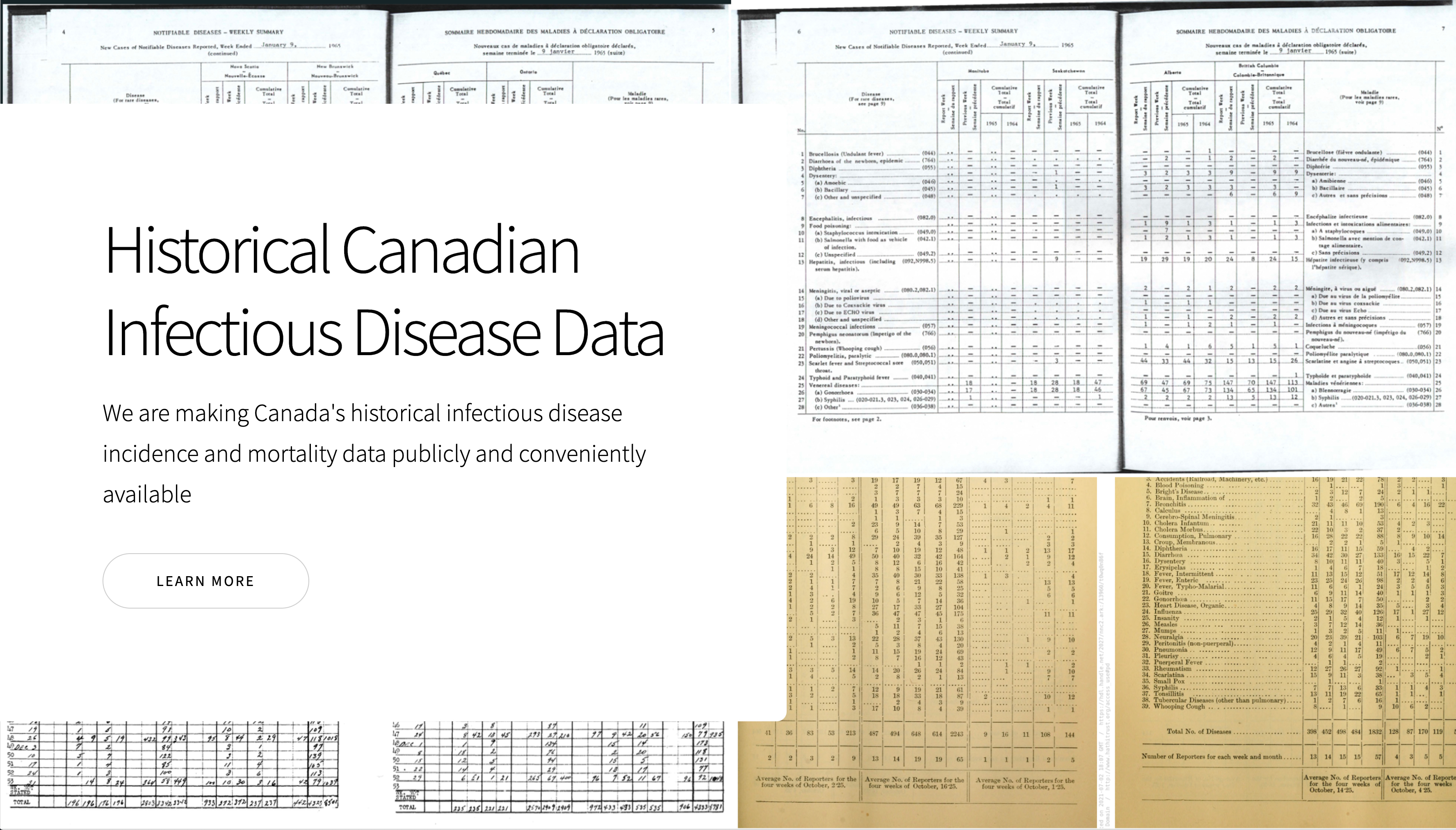|
![]()
| Canadian Disease Incidence Dataset (CANDID) DataStudy1 #699814 We are making Canada's historical infectious disease incidence and mortality data publicly and conveniently available. [3] | 
- We are systematically contacting data stewards across Canada to access the disparate source documents that contain Canada's historical infectious disease data. We are making scans of these documents conveniently available for all.
- We are producing reproducible automated processes for converting the digitized spreadsheets into tidy data structures. These data structures contain all of the information in the original source documents, but are more convenient for analysis and discovery
Tags: CANMOD – Infectious Disease Data Digitization |
+Citations (3) - CitationsAjouter une citationList by: CiterankMapLink[3] Over a Century of Infectious Disease Surveillance in Canada: Introducing the Canadian Disease Incidence Dataset (CANDID)
En citant: David J. D. Earn, Gabrielle MacKinnon, Samara Manzin, Michael Roswell, Steve Cygu, Chyunfung Shi, Benjamin M. Bolker, Jonathan Dushoff, Steven C. Walker
Publication date: 20 December 2024
Publication info: medRxiv 2024.12.20.24319425
Cité par: David Price 0:09 AM 24 March 2025 GMT
Citerank: (6) 679758Benjamin BolkerI’m a professor in the departments of Mathematics & Statistics and of Biology at McMaster University, and currently Director of the School of Computational Science and Engineering and Acting Associate Chair (Graduate) for Mathematics.10019D3ABAB, 679776David EarnProfessor of Mathematics and Faculty of Science Research Chair in Mathematical Epidemiology at McMaster University.10019D3ABAB, 679814Jonathan DushoffProfessor in the Department Of Biology at McMaster University.10019D3ABAB, 699816CANMOD – DataWe are working to collect, digitize, and curate infectious disease data, and to make these data accessible to modellers and other stakeholders.161AED8BA, 701020CANMOD – PublicationsPublications by CANMOD Members144B5ACA0, 715290Steve WalkerSteve is the CANMOD Director of Data Science and a postdoctoral fellow in the Department of Mathematics and Statistics at McMaster University.10019D3ABAB
URL:
DOI: https://doi.org/10.1101/2024.12.20.24319425
| | Extrait - [medRxiv, 20 December 2024]
Background: Canadian notifiable disease surveillance provides data on the incidence of communicable diseases, dating back to the late 19th century. The Public Health Agency of Canada offers summaries of these data (from 1924–2022) through an online portal. These summaries provide historical context for Canadian health researchers, but lack information on intra-annual and inter-provincial patterns. Sub-annual and sub-national data can be found in published documents, or requested from archives of government agencies, but are only available in typewritten or handwritten hard copies. We digitized and collated these data sources to create a resource for epidemiology and public health.
Methods: We manually entered data from scans of hard copies into spreadsheets resembling the originals, facilitating accurate transcription through easier cross-checking. We developed open-source pipelines to harmonize these spreadsheets into CSV files that blend data across sources.
Results: We assembled and processed 1,631,380 incidence values from 1903–2021. Focusing on sub-annual and sub-national data and removing redundancy yielded 934,009 weekly, monthly, or quarterly incidence values broken down by province/territory, containing 139 diseases. We give two examples of sub-annual and sub-national patterns: strong annual cycles of poliomyelitis that peaked simultaneously across provinces, and spatially heterogeneous resurgence of whooping cough in the 1990s.
Interpretation: Canada’s history of infectious disease surveillance has produced a detailed record of sub-annual and sub-national disease incidence patterns that remains largely unexplored. This important record is now available as the Canadian Disease Incidence Dataset (CANDID), hosted on a publicly accessible website along with the pipelines used to create it and scans of the original sources. |
|
|